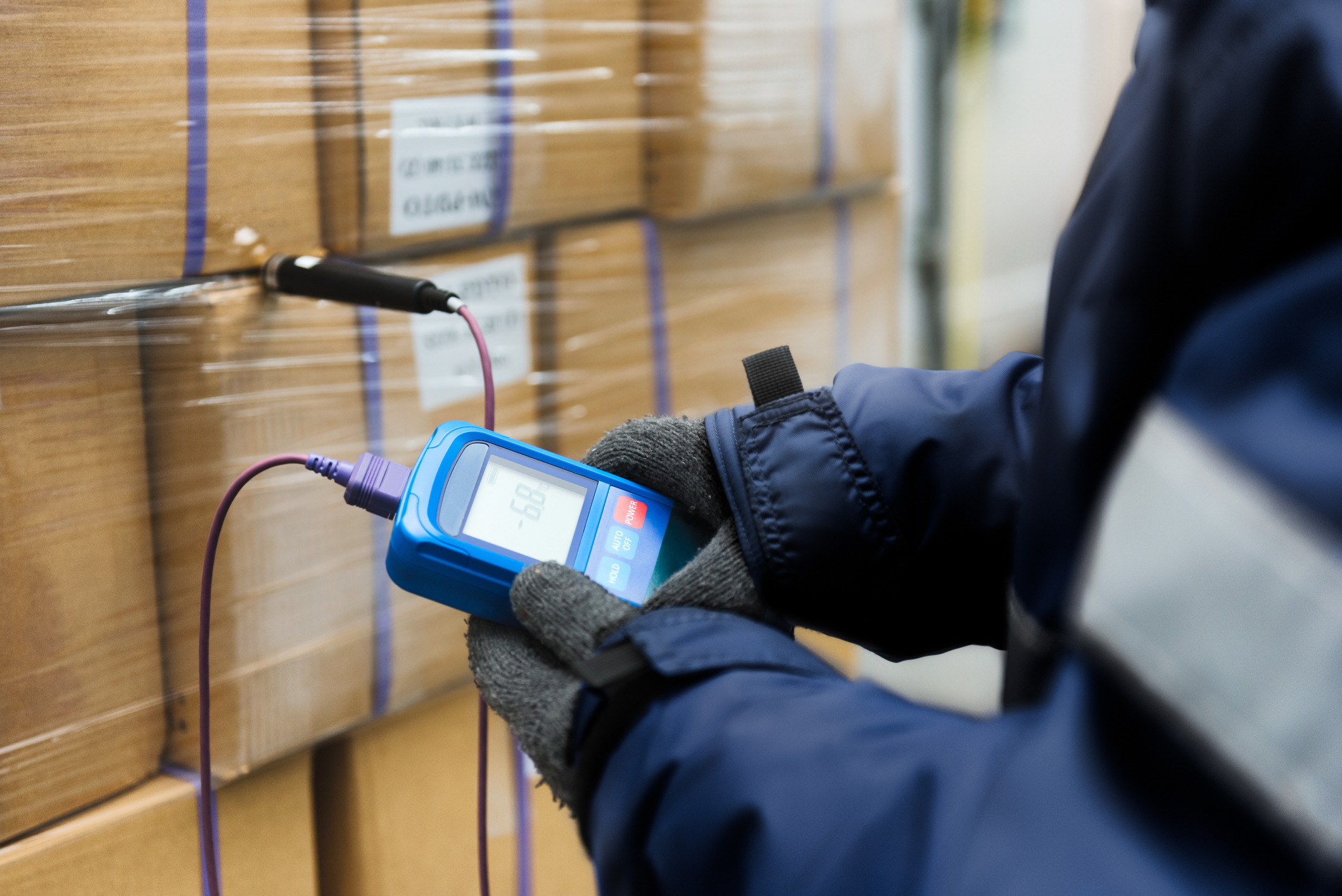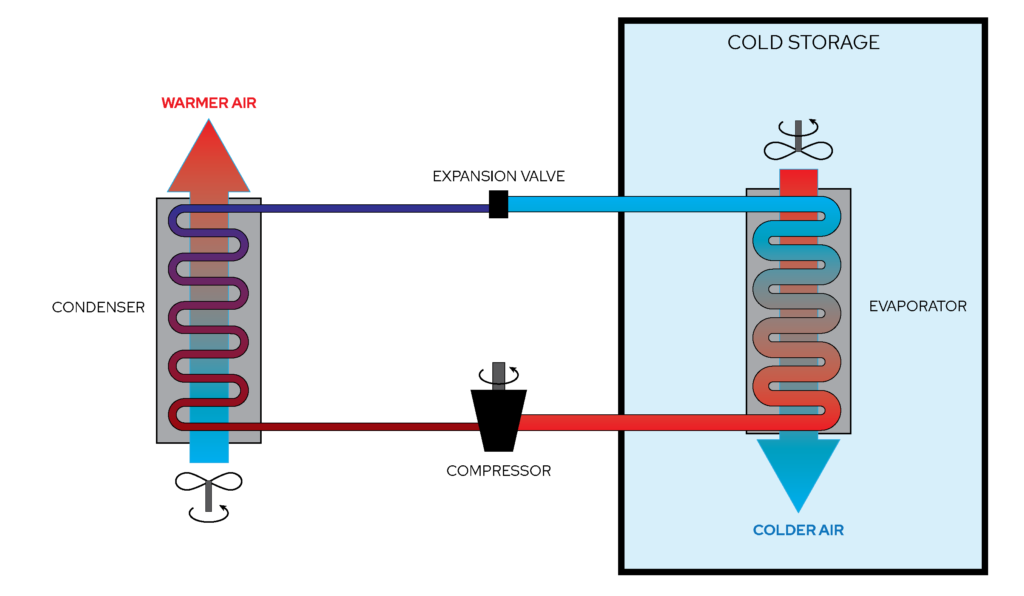
The need for frozen and refrigerated warehouse storage is higher than ever. Manufacturers of temperature-sensitive goods, such as drugs, health and beauty products, food, and other perishable items, can use cold storage to preserve large batches rather than making small batches and shipping them immediately.
Because these products must stay at a continuously low temperature to avoid spoiling, every part of the supply chain, known as the “cold chain,” must play its part to prevent accidental climate swings.
While cold chain packaging handles the bulk of the temperature regulation during shipment, sensitive products must also pass through a cold storage warehouse for temporary storage. In many cases, a cold storage room was their origin point.
What Is Cold Storage?
A cold storage facility is a warehouse with strict climate controls that maintain a specific temperature. Some cold stores keep temperatures below freezing, ranging from 32 degrees Fahrenheit to below 0 degrees. Refrigerated warehouses maintain temperatures between 35 degrees and 55 degrees Fahrenheit.
Products that require ultra-low temperatures, such as certain pharmaceuticals, may require conditions as cold as -122 degrees Fahrenheit. By running at stable, low temperatures, a commercial cold storage facility can safely store sensitive foods, medicines, and other products before they ship to the end-user or another cold storage building.
Overview of temperature control for safety
Temperature controlled shipping is a fundamental aspect of cold chain operations. It involves maintaining specific temperature ranges that are optimal for the particular product being transported. By closely monitoring and controlling temperatures, businesses can prevent the growth of harmful bacteria, maintain product freshness, and ensure the efficacy of sensitive medications or vaccines. Temperature controlled shipping is a critical factor in preserving the safety and quality of controlled products throughout their journey from origin to destination.
How Do Cold Storage Warehouses Work?
The first and perhaps most important piece of the cold storage puzzle is a suitably sized and well-maintained HVAC system to pump in cold air. The system uses piped coolant to absorb heat, and then it uses fans and radiators to distribute the chilled air through a network of ducts placed strategically in the chilled facility. Let’s break down the cooling system’s various parts further:

1. The Compressor
This component forces coolant through the HVAC system, which causes the coolant to heat up. This heated coolant then moves to the condenser.
2. The Condenser
As warm coolant arrives in the condenser, it changes from gas to liquid. The condenser then draws the heat from the coolant before it moves to the receiver. The removed heat goes back into the atmosphere.
3. The Expansion Valve
The expansion valve restricts the liquid refrigerant flow and creates a pressure difference as it meters the amount of refrigerant entering the evaporator.
4. The Evaporator
In the evaporator, the coolant transforms from liquid to gas. As the coolant does so, it draws heat from the warehouse, cooling it down. It then goes back to the compressor to begin the process again.
Cold storage facility HVAC systems operate much like those found in homes. They simply work on a much larger scale. As such, the climate control equipment is robust and capable of chilling higher amounts of square footage than what a home AC system would be capable of.
In addition to climate controls, cold storage warehouses use construction techniques to lock in cold and keep heat out. These facilities ensure stable temperatures without overloading the HVAC system by employing insulation layers in the walls, floors, and ceilings.
Why Are Cold Storage Facilities Important?
Without proper cold storage, many products the average consumer enjoys and takes for granted would never reach them. Refrigeration and freezing maintain product viability and prevent spoiling.
Consider perishable food. Many foods available in grocery stores, such as fruits and vegetables, are not native to the area where they are being sold, and they may even be sold out of season. That is only possible because of cold storage and transportation, which can maintain freshness in various locations throughout the year.
Additionally, many pharmaceutical products, such as vaccines, require precision temperature controls to be effective. Losing drugs and medicine to poorly implemented cold storage results in colossal profit loss and can result in significant public harm and loss of life.
Since creating these vaccines and medicines is time-consuming and costly, manufacturers and healthcare facilities take great strides in ensuring their products are safe to use.
Cold storage is also essential for certain electronics, like susceptible devices in the health industry. Temperature can affect device tolerances and their ability to take accurate readings, and temperature swings can result in condensation and cause the internal wiring to short out.
Antiques, musical instruments, and artwork can also benefit from refrigerated storage. Wood, in particular, can expand and contract at varying rates, causing glued joints to become stressed and separate. Storing priceless artifacts and heirlooms in precise, temperature-controlled conditions can last far longer than they would if exposed to the elements.
Types of Cold Storage Facilities
Product requirements vary as widely as temperatures do. When a business searches for “cold storage facilities near me,” the results can bring up warehouses with vastly different temperature conditions. Some keep temperatures far below freezing, and others maintain a climate similar to that of a commercial refrigerator or even warmer.
Typically, cold storage warehouses can be broken down into two main types:
Refrigerated Warehouses
Refrigerated warehouses are usually used to extend the shelf life of food. Fruits, vegetables, and other foods that don’t require freezing can stay edible while stored in temperatures ranging from mid-30 degrees Fahrenheit to mid-50 degrees.
Frozen Cold Storage Warehouses
Freezers typically operate at 0F. Some facilities are equipped with dedicated laminar flow of cold air to accelerate the freezing time.
These facilities are perfect for food items that must maintain strict safety standards and remain frozen lest they spoil and spread dangerous foodborne illnesses. Fish, meat, and poultry are typical, but frozen produce and ice cream benefit from sub-freezing storage.
Who Uses a Cold Storage Facility?
Many industries require cold storage at some point in their operations. However, a few could not exist without widespread and reliable cold storage:
Food Industry
Nearly every grocery store item needed cold storage at some point in production. Fruits and vegetables require constant refrigeration to avoid spoiling, and animal products must stay refrigerated or frozen to be safe for consumption. From food production at farms and packaging facilities to beverage producers, meal kit companies, and restaurants, cold storage is essential for public safety.
Pharmaceuticals
During the manufacture and storage of drugs and medicine, strict temperature controls must be maintained for many products to remain effective. For instance, vaccines, many of which rely on dead bacteria or viruses, must stay cold, or the vaccines can lose potency.
Even capsules and pills can lose effectiveness in extreme temperatures and must be transported and stored in a chilled state.
Life Sciences
The study of living organisms requires taking and transporting many samples of living tissue and organic material. This material must stay intact throughout the journey to remain viable to scientists. Scientific experiments require removing variables, and temperature extremes that can damage samples can ruin an experiment.
Speciality Products
Fragile artwork and sensitive electronic devices must be stored in facilities that maintain constant temperatures and humidity. Ancient artifacts, such as fossils and thousand-year-old clay pots, can be damaged permanently by temperature swings.
How to Choose a Cold Storage Facility
The most critical factors for choosing a cold storage facility are:
- Does the facility operate at the required temperature?
- Does the facility have a reputation for stability and reliability?
- Is the location of the facility near your production center?
- Is the facility near your customer base?
- Is the facility easy to access via truck, ship, train, or plane?
- What is the storage space you can access?
- Can the facility let you monitor your goods?
- What is the nature of the monitoring? (i.e., Is it real-time, secure, or remote?)
- What is their security like?
- Does the facility have solid inventory control?
- Can the facility provide extra value, such as packaging and kitting?
Once these questions are answered, you can ask, “What is the cost?” Expect to pay an average $50 per pallet for the first month of cold storage While this price is higher than standard warehousing, maintaining a constant temperature incurs high construction and running costs for the cold storage company.
Find Innovative Cold Chain Solutions at Pelton Shepherd
Cold storage facilities are vital for preserving perishable goods like food and pharmaceuticals. They maintain optimal temperature and humidity levels, extending the shelf life of products, reducing waste, and ensuring safe consumption. These facilities play a crucial role in supply chains, supporting food security and public health while minimizing economic losses.
Pelton Shepherd is dedicated to providing customers with environmentally sound, effective cold chain solutions that protect the integrity of products sensitive to temperature. Our shipping ice packs allow businesses to precisely control the temperature of their packages without creating hazardous waste.
Pelton Shepherd is at the forefront of ecologically friendly packaging solutions that outperform the competition, from compostable gel packs to drain-safe gels. We strive to stay at the top of our industry by providing top performance and environmental sustainability. Learn more today!


